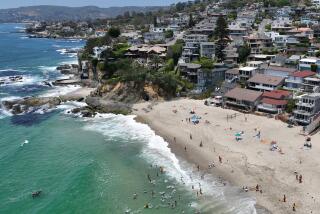In tiny Cayucos, Fourth of July means one thing: a huge party
CAYUCOS, Calif. — One day each year, this beach town of less than 3,000 residents becomes among the most populous places on the Central Coast.
Some 30,000 people show up for a parade featuring floats that locals have worked on for at least two or three days before the event, children doing cartwheels and — when they aren’t otherwise booked — marching bands.
There’s a heavy law enforcement presence, partly guaranteed by the barbecue that Bill and Carol’s Sea Shanty prepares for officers. There is drinking: At some point each year, Rick Roquet, proprietor of the Seaside Motel with his wife, Rebecca, trades his jaunty straw parade hat for his “drunk hat,” a beer-stained relic adorned with a faded red, white and blue pinwheel.
But it is so safe that people set their beach chairs out unattended along the parade route days before the event, and no one touches them.
“The same people have been coming for the past 20 years,” said Hani Dagher, who presides over a liquor store on the main street, which is also well-stocked with plastic sand buckets and dog toys. “On Sunday, the hotels will ask the people, ‘Do you want to book for next year?’ And they’ll say yes, because they know if they don’t they’ll lose their reservations forever.”
This year, one of the Shoreline Inn’s Fourth of July regulars was ill. She came for many years with her husband and came back with her grandchildren after he died.
“Her family called and said that she was in a hospital bed and she couldn’t stop worrying about her reservation,” said owner Laila Kollman. “I told them she’d always have her room. I’ll rent it out this year. But it’s hers when she’s better.”
No one is sure when Cayucos’ love affair with the Fourth started. There’s an 1893 photo featured in the 2013 Historic Cayucos Calendar of a parade on Ocean Avenue, back in Cayucos’ gunslinger days. According to the community’s tourism website, Cayucos “enjoyed a colorful youth with gamblers and rum runners frequenting the Cayucos Tavern — a local favorite to this day.”
Cayucos’ lawlessness these days tends toward people jumping off the old wooden pier and letting dogs play leash-free.
Families from the Central Valley lease the same summer houses year after year; about 70% of Cayucos’ property-rental business comes from Fresno, Bakersfield and Visalia. The community has no room to grow, hemmed in by ocean, the city of Morro Bay and protected land.
The parade has “never, ever, ever been promoted,” said Andy Lilley, vice-president of the Cayucos Lions Club. “But we do put up signs at both ends of town.”
Bill Shea and Carol Kramer of the restaurant Sea Shanty are widely acknowledged to come up with the best floats.
“The surfers used to be our major competition,” Kramer said. “They had the best float of all time. We had a famous dog in town, a black-and-white dog with a curly tail that hung out with the surfers. The surfers made a float that looked just like that dog, and when it got to the judges it lifted its leg and sprayed water on them.”
The surfers’ efforts have since ebbed “to a few guys playing guitars in the back of a pickup truck,” Shea said.
Behind the restaurant on Tuesday, a float on the framework of what was once Kramer’s favorite car was taking on the shape of a duck. Kramer was wearing camouflage shorts and a hat — they were going to spoof the reality show “Duck Dynasty.” Shea was handing out plastic duck calls that made resounding quacks.
“There’s no way for the driver to see,” Carol said, pointing to breast feathers over the window.
“There never is,” said artist Tom Reno, who was painting the beak. He said he spent 25 years on the Central Coast developing “the skills of a sign painter and the philosophy of a yogi.” Now he lives in Santa Fe, N.M., but returns each year to his role as “Float Guy.”
Roquet, the motel owner, showed up to the duck float with two big white buckets. Each year Shea provides the Bloody Mary mix and Roquet adds the vodka, and they take a little cart around delivering drinks to people in the parade.
Roquet said a Cayucos Fourth is “crazy fun — but a good crazy.”
“This street will be filled — an ocean of people,” he said, throwing his arms wide. “They’ll all make their way down the street till they get to the parade and then, well, even my crew will say, ‘What? This is just a bunch of old people, kids and dogs.’ ”
By crew he means the people who have rented the 12 rooms at his Seaside Motel on the Fourth of July for 30 years.
On Tuesday afternoon they were already gathering with hot dogs and chests of beer on the motel’s patio.
“When we first started coming here, we weren’t friends. We didn’t even know each other. But now we’re family,” said 59-year-old Stacey Clem, in town with her husband and grandchildren. “We’ve been through death, marriage, babies, drugs, weddings, all of it together. And we always come back to this patio.”
When Rebecca Roquet’s mother, Gardyce, died this year, Clem flew out from Missouri for the funeral. When Rachelle Wiseman, 33, of Modesto, married last year, the entire Fourth crowd came to her wedding in Cayucos. She had spent every Fourth at the Seaside Motel since she was a toddler.
This week, the entire town had the air of a reunion. People stopped in the street to hug hello. Perhaps the only people who did not know the Cayucos Fourth of July routine by heart — sandcastle building contest beginning at 5 a.m., parade, barbecue, Bingo, then fireworks over the pier — was the family who had taken to calling themselves the Griswolds, after the disaster-prone family in the series of “National Lampoon” vacation movies.
They had come to the California coast from Colorado in an RV that broke down on the sand dunes near Pismo Beach. There was an emergency room trip after a family member fell — well, it’s a long story, said Ed Corridori.
But grandparents, parents, three children and two cousins had ended up here at sunset Tuesday, while golden retrievers frolicked on a beach, a boy cannonballed off the pier and couples paused to watch dolphins.
“It’s so pretty. And there were all those chairs on the main street, just sitting there,” said Stephanie Corridori. “We didn’t know this existed.”
More to Read
Sign up for Essential California
The most important California stories and recommendations in your inbox every morning.
You may occasionally receive promotional content from the Los Angeles Times.











